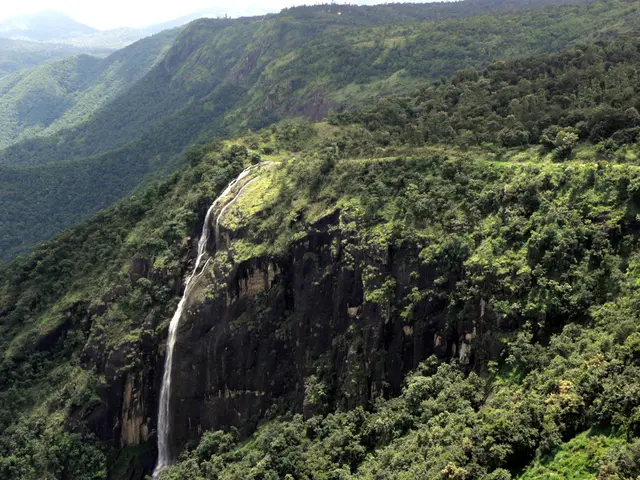Discovering Elusive Gems: Tales and Treasures of Priceless Stones
In the world of precious stones, a select few stand out for their rarity and captivating beauty. These gemstones, formed through natural geological processes or engineered in laboratories, have captured the imagination of collectors and jewellery enthusiasts alike.
One such lesser-known gemstone is Blue Garnet, which changes colour depending on lighting. But it's not just the Blue Garnet that captivates; other rare gemstones such as Mahenge Spinel, a highly sought-after collector's item, and Tanzanite, discovered in the Mererani Hills of Tanzania, have garnered significant attention.
The journey of a rare gemstone from its natural state to a finished product is a complex one, involving multiple layers of craftsmanship and trade. Each step in this process, from mining to market, adds value and contributes to the gem's final price.
For instance, Umba Valley Sapphires were discovered in the mid-20th century in Tanzania, named after the Umba River that flows through the region. Red Beryl, discovered in the Wah Wah Mountains of Utah, is another rare gemstone that has captured the interest of gem enthusiasts.
The formation of these rare gemstones occurs through natural geological processes that take thousands to millions of years deep within the Earth, involving heat, pressure, and the presence of specific minerals. Key factors in gemstone formation include high temperature and pressure in the Earth's crust or mantle, the presence of specific chemical elements, and time—often millions of years—for the crystals to grow to gem quality.
Besides natural formation, rare gemstones can also be created synthetically in laboratories through several engineered processes designed to mimic or accelerate natural growth. These processes allow control over the gemstone's characteristics and can produce colours or qualities that are very rare or do not exist naturally.
Some common lab-growth methods include Flame Fusion (Verneuil), Czochralski (Crystal pulling), Hydrothermal Growth, Flux Growth, High Pressure High Temperature (HPHT), and Chemical Vapor Deposition (CVD). Among these, hydrothermal growth closely imitates the natural formation by using high pressure and temperature in a water-based solution, allowing normally insoluble materials to dissolve and recrystallize on a seed crystal.
Rare gemstones like Jadeite, predominantly found in Myanmar, have been used for thousands of years in China and other East Asian nations. Grandidierite, a lesser-known gemstone found only in Madagascar, was discovered by French botanist Alfred Grandidier in the early 20th century. Benitoite, discovered in the remote terrains of San Benito County, California in 1907, was originally mistaken for a sapphire. Poudretteite, discovered in the quarries of Mont St. Hilaire, Quebec in the 1960s, is named after the Poudrette family who operated the quarry.
Mahenge Spinel, discovered in the Mahenge region of Tanzania in 2007, rivals the finest rubies in colour intensity. Taaffeite, discovered accidentally by Irish gemologist Richard Taaffe, is another rare gemstone that has intrigued collectors. The initial discovery of Mahenge Spinel yielded some of the largest and most vibrant spinels ever seen.
Alexandrite, discovered in the Ural Mountains of Russia in the early 19th century and named in honour of the future Tsar, Alexander II, is another rare gemstone that has captivated collectors for centuries. Black Opal, discovered in the late 19th century in Lightning Ridge, Australia, is known for its play of colour, displaying a range of hues when viewed from different angles.
In summary, rare gemstones form naturally over immense geological timescales through complex processes of heat, pressure, and mineral chemistry, but can also be grown artificially using advanced lab techniques that replicate or accelerate these natural wonders. Whether found in remote terrains or created in laboratories, these rare gemstones continue to captivate and inspire collectors and jewellery enthusiasts alike.
- Trace elements play a crucial role in gemstone formation, specifically the presence of specific chemical elements contributing to the unique characteristics and colors of these precious stones.
- Science, particularly environmental and geological, is instrumental in understanding the formation of rare gemstones, shedding light on the processes that take thousands to millions of years deep within the Earth.
- From a collector's perspective, the world of rare gemstones extends beyond jewelry, intersecting with various domains like fashion and beauty, lifestyle, food and drink, home and garden, technology, and travel.
- Technology has a significant role in the creation of synthetically grown rare gemstones, with several engineered processes mimicking or accelerating natural growth to produce colors or qualities that are very rare or do not exist naturally.
- Whether found in remote locations or produced in laboratories, rare gemstones like Jadeite from Myanmar, Grandidierite from Madagascar, and Benitoite from California continue to captivate the interest of environmental scientists, collectors, and jewellery enthusiasts alike.




